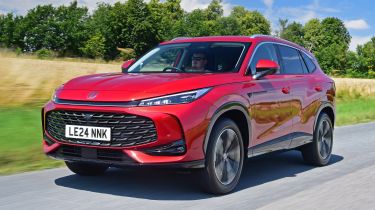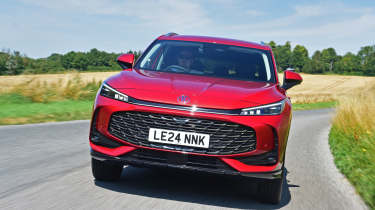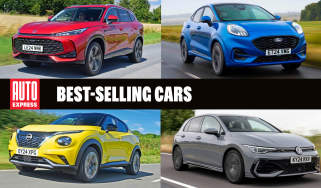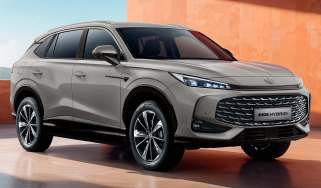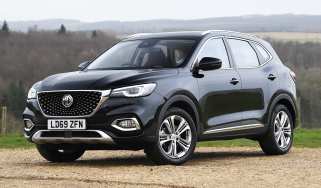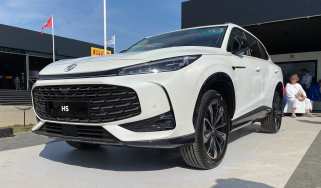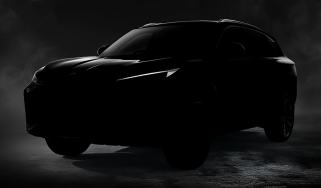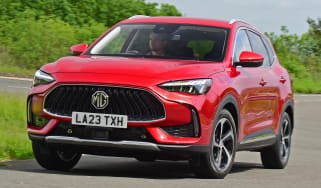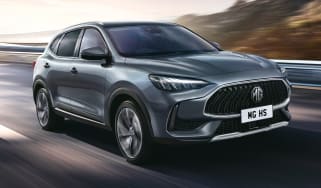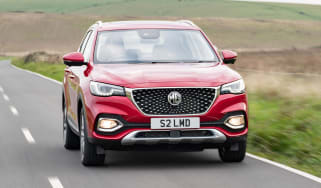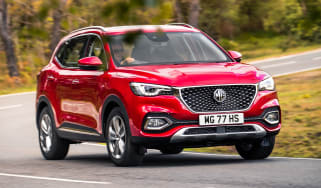MG HS review
The MG HS might be an inexpensive mid-size SUV, but it’s not missing any kit or quality

Our opinion on the MG HS
The MG HS will appeal to drivers who like getting their money’s worth, or perhaps are on a tight budget but still want a practical SUV for their next family car. Value for money is still front and centre with MG’s mid-size SUV, which comes generously equipped, feels spacious and has a starting price that’s less than the best-selling Ford Puma.
However, we’d strongly recommend waiting for the hybrid model, rather than settling for the noisy pure-petrol version. If you can’t wait, the plug-in hybrid (PHEV) HS is much more refined and will appeal to company car drivers because it offers a huge EV range of 75 miles. Handily, the PHEV is no less practical and has a starting price of £31,495, which is not that much more than a regular petrol-automatic version.
| Key specs | |
| Fuel type | Petrol, full-hybrid and plug-in hybrid |
| Body style | Mid-size SUV |
| Powertrain | 1.5-litre, 4cyl, petrol, front-wheel drive 1.5-litre, 4cyl, petrol plus 1x e-motor* (not available to order yet) 1.5-litre, 4cyl, petrol plus 1x e-motor, 24.7kWh battery |
| Safety | 5 stars (Euro NCAP, 2024) |
| Warranty | Up to 7 years/80,000 miles |
About the MG HS
MG has really been keeping us on our toes in 2024 with a new car blitz that’s included the simply excellent MG3 supermini, which we recently crowned as our Affordable Hybrid Car of the Year, and the long- and feverishly awaited MG Cyberster sports car.
But while the second-generation MG HS might not capture the imagination the way a pure-electric roadster with scissor doors can, it’s more important for the brand. The out-going model was MG’s biggest seller in the UK and, so far this year, it is mixing it with the top-10 best-selling cars in the country.
Used - available now
It appealed, first and foremost, to budget-conscious motorists by dramatically undercutting the competition in the very popular mid-size SUV class, and so does the latest HS. Prices start from just under £25,000, which is less than £1,000 more than its predecessor.
Like before, a generous standard kit list sweetens the deal. The entry-level SE trim comes with dual 12.3-inch displays, sat-nav, Apple CarPlay, Android Auto, LED headlights, keyless entry, a reversing camera and 19-inch diamond-cut wheels. Plus, every HS features the ‘MG Pilot’ suite of driver assistance tech.
Most buyers are expected to upgrade to Trophy specification though, as it only costs £2,500 extra and adds a wireless charging pad, an upgraded sound system, a 360-degree surround-view camera, dual-zone air-conditioning, a powered tailgate and heated front seats with black leather-style upholstery as standard – or tan for an additional £600.
In addition to the two trim levels, the MG HS is currently available with either a pure-petrol or plug-in hybrid powertrain, and a full-hybrid version is coming in 2025. All of them incorporate a 1.5-litre petrol engine, with the hybrid versions adding some assistance from an electric motor.
The plug-in hybrid MG HS starts from just under £31,500 – another impressive feat of pricing, and not much more than a regular petrol-automatic version. The forthcoming full-hybrid will hopefully split the difference between the PHEV and basic pure-petrol models, delivering a more refined and slick driving experience than the petrol.
If you're interested in getting yourself an MG HS, we can help. Configure your ideal MG HS now to get top offers from local dealers, check out the latest MG HS leasing deals or search for used MG HS models with our Find A Car service. You can even sell your existing car for a great price with Auto Express Sell My Car.
Engines, performance & drive

| Pros | Cons |
|
|
Our first experience of the MG HS has been the pure-petrol automatic version, and to say we weren’t overly satisfied with the driving experience would be something of an understatement.
The biggest issue for us is the constant, nonsensical bonging and chiming caused by the various safety systems. This can be so distracting that we often find ourselves looking down regularly to see what the problem is, which triggers further warnings to remind us to pay attention to the road. Switching the systems off is equally infuriating, as it requires going through menu after menu on the touchscreen. And even when you find the right page, the icons are so small that it’s hard to press them on the move. In some cases, you must then confirm that you definitely want to disable the feature.
Then there are the brakes. During our drive, we felt they didn’t do much until about halfway through the pedal travel, and then required significantly more force before the car began to slow down. Meanwhile, the steering in its ‘normal’ setting is quite heavy, so we much preferred the lighter ‘comfort’ mode. Whichever mode you use, the steering is still slow and vague, to the point that you’re guessing how much lock is required when going around a corner.
We also got a brief taste of the plug-in hybrid version and, almost immediately, this proved to be the far superior choice. Adding regenerative braking seemed to solve the brake pedal problem because it felt far more natural, and the transition to the physical discs was imperceptible.
Performance, 0-60mph acceleration and top speed
The petrol HS uses a turbocharged 1.5-litre petrol engine that produces 167bhp and 275Nm of torque, which is enough to get from 0-62mph in under 10 seconds. However, in the automatic version we tried, the car took about a second to respond whenever we hit the throttle when trying to accelerate hard. When accelerating, it sounds strained, emitting a loud and rather gravelly note as we slowly gained speed.
In comparison, the plug-in hybrid HS with a total output of 366bhp suffered from no such issues. Power delivery from its electric motor is instant, making for effortless acceleration and a 0-62mph time of 6.8 seconds. It often felt like we were driving an EV because the electric motor provided enough acceleration to keep up with traffic without needing to wake the engine, even when we stomped on the accelerator.
We’re yet to try the Hybrid+ version, but it could prove to be the Goldilocks version of the range, offering up a respectable 221bhp and a swift 0-62mph time of 7.9 seconds.
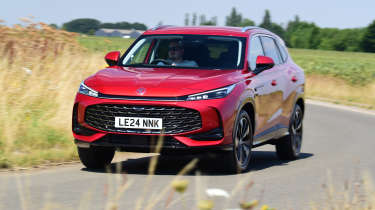
Town driving, visibility and parking
The ride is firm but not uncomfortable at low speeds, and the high driving position offers a good view ahead.
All versions of the MG HS come with front and rear parking sensors, plus a reversing camera to help make parking in a tight multi-storey just that little bit easier. The top-of-the-range Trophy version features a full 360-degree camera system, should you require additional camera views.
B-road driving and handling
For the most part, the MG HS feels stable, but reach an uneven section of road and hit a succession of bumps, things become quite bouncy. Combined with the vague steering feel and awkward brake pedal modulation, the HS isn’t as fun to drive as rivals like the Mazda CX-5 or SEAT Ateca.
Motorway driving and long-distance comfort
We found the HS best suited to the motorway, where, aside from a fair bit of road noise, it’s a reasonably quiet place once the engine has settled down.
All versions of the MG HS are fitted with adaptive cruise control to help you maintain a safe distance from the car in front, lane keep assistance to help keep you within your lane, and a blind spot monitoring system to warn you of vehicles alongside when you go to change lanes.
| Model | Power | 0-62mph | Top speed |
| MG HS petrol manual | 167bhp | 9.4 seconds | 118mph |
| MG HS Hybrid+ | 221bhp | 7.9 seconds | 118mph |
| MG HS plug-in hybrid | 366bhp | 6.8 seconds | 102mph |
MPG & running costs
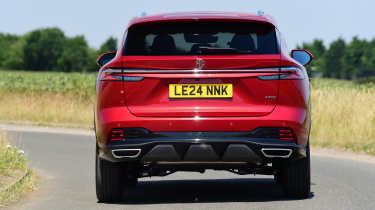
| Pros | Cons |
|
|
MG says the petrol HS should be able to average 38.2mpg when equipped with the six-speed manual, or up to 37.2mpg with the optional seven-speed automatic. During our testing of the automatic version across a mixture of town and motorway driving, we managed to achieve 33.6mpg – the equivalent Nissan Qashqai or Kia Sportage should return over 40mpg in similar conditions.
The full-hybrid HS offers more respectable fuel economy of 51.3mpg, and it will be capable of driving on pure electric power for short periods without needing the engine to run. It’ll be easier to run for those who don’t have a regular place to charge than the PHEV because it doesn’t require plugging in: the battery is charged by regenerative braking and the engine, just like other full-hybrid cars.
| Model | MPG | CO2 | Insurance group |
| MG HS 1.5 T-GDI SE manual | 38.2mpg | 168g/km | 24A |
| MG HS 1.5 T-GDI SE DCT | 37.2mpg | 173g/km | 25A |
| MG HS 1.5 Hybrid+ | 51.3mpg | 126g/km | N/A |
Electric range, battery life and charge time
The big news is that the plug-in hybrid HS gets a sizable 24.7kWh (23.2kWh usable) battery and boasts a massive pure-electric range of 75 miles – nearly twice the distance the Kia Sportage PHEV can go on a single charge. However, we haven’t had a chance to see how accurate that range is for ourselves yet.
MG says the HS should take around four hours to charge from empty to full at home when utilising a 7kW charge point. If you use a domestic three-pin plug, it’ll take seven and a half hours.
| Model | Battery size | Range | Insurance group |
| MG HS 1.5 T-GDI PHEV SE | 24.7kWh (23.2kWh usable) | 75 miles | 26A |
Insurance groups
Insurance costs are likely to be a little higher with the MG HS when compared with its rivals. The entry-level 1.5 T-GDi SE stars in group 24, before rising to group 26 for the plug-in hybrid model. The Ford Kuga and the hybrid version of the Hyundai Kona both start in group 16.
Tax
Due to the plug-in hybrid HS having such a long EV range figure and emitting just 12g/km of CO2, it’s in a low 5 per cent Benefit-in-Kind (BiK) tax rate for company car drivers. In order to beat that, you’ll need to drive a pure-electric car that’ll likely cost far more in the first place.
If you’re wondering, the petrol HS falls into the highest 37 per cent band, making it a costly option. In comparison, the Hybrid+ version is charged at 31 per cent.
At least the affordable pricing of the MG HS means it avoids the supplementary surcharge for cars that cost over £40,000 when new. This means the HS is charged at the standard rate of vehicle excise duty (VED), whether you go for a petrol, plug-in hybrid, or regular hybrid version.
Depreciation
Based on a typical ownership period of three years or 36,000 miles, our expert data suggests that the MG HS will retain between 46 to 48 per cent of its resale value, with the best being the 1.5 Trophy manual, and the worst being the 1.5 Hybrid+ in SE trim.
That’s lower than the Kia Sportage, which is predicted to maintain between 51 to 58 per cent over the same period, or the Ford Kuga, which is expected to hang on to around 53 per cent of its value.
To get an accurate valuation of a specific model, check out our free car valuation tool...
Interior, design & technology
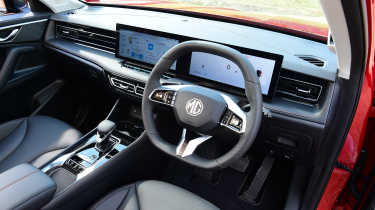
| Pros | Cons |
|
|
The MG HS is really well-equipped as standard. All models in the range come with two 12.3-inch display screens, sat-nav, Apple CarPlay, Android Auto, LED headlights, keyless entry, a reversing camera, and 19-inch alloys. Adaptive cruise control, autonomous emergency braking (AEB), traffic jam assist, blind spot assist, and rear cross-traffic alert are all included as standard, too.
Move up to the slightly more pricey Trophy trim, and you get all that plus wireless phone charging, a 360-degree camera, a stereo upgrade, dual-zone climate control, a powered tailgate and heated front seats.
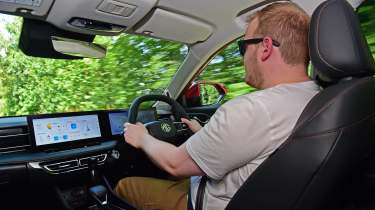
Interior and dashboard design
For its second generation, the MG HS has stepped up its game in several areas. For starters, the design is much cleaner and more sophisticated this time around, incorporating a full-width rear light bar, sharper headlights, and a whopper of a front grille – a styling cue shared with the MG3.
Materials and build quality
The interior is all new and looks far more modern than before. We were particularly impressed by the material and build quality, especially considering the price tag, because everything feels well screwed together, and most surfaces are covered with soft-touch or squishy materials. It’s only lower down on the door cards or centre console that you’ll start to find hard, cheaper-feeling plastics.

Infotainment, sat-nav and stereo
Technology has seen some definite upgrades compared to the previous MG HS. That being said, the large central touchscreen and digital driver’s display are the same as those in other MGs, so resolution and loading times are below average for this class. We’re also familiar with the infotainment system, which does the job but can be tedious to navigate. We expect most people will just bypass it using Apple CarPlay or Android Auto. Unfortunately, you’ll need to use a cable with them because neither offers wireless connectivity.
There isn’t an option to get an uprated sound system, so the only difference is that you get a 6-speaker system with the entry-level SE or an 8-speaker version in the top-of-the-range Trophy.
Boot space & practicality
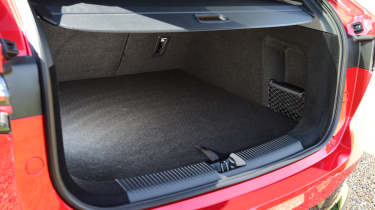
| Pros | Cons |
|
|
To make the HS more practical than its predecessor, the wheelbase is 45mm longer, and the car is 14mm wider. Even with six-foot-tall adults up front, there’s plenty of legroom in the seat behind for anyone similarly tall to sit comfortably, with headroom to spare, and space under the front seats to tuck their feet under the seat in front.
Alternatively, if you’ve got young children, the wide rear door opening will help when installing a child seat, and there are easily accessible ISOFIX points for the outer positions. Another small detail we appreciate is that there are more storage cubbies in the latest HS, including large door bins and a cavernous glove box.
Dimensions and size
At 4,655mm long (4,670mm for the PHEV), 1,890mm wide and 1,664mm tall, the MG HS is a little larger than key rivals such as the Kia Sportage, which was already one of the largest mid-size SUVs at 4,515mm long, 1,865mm wide, and 1,650mm high. Even though the MG is one of the larger models in its class, you shouldn’t have trouble finding a suitable parking spot.
| Dimensions | |
| Length | 4,655mm (4,670mm plug-in hybrid) |
| Width | 1,890mm (2,066mm inc. mirrors) |
| Height | 1,664mm |
| Number of seats | Five |
| Boot space | 507-1,484 litres |
Driving position, seats & space in the front
There’s plenty of space inside the MG HS, and there should be enough headroom for the tallest driver and front seat passenger. There are some useful cubby spaces to store water bottles and, on higher-spec models, there’s a wireless smartphone charger for your phone.

Seats & space in the back
Just like in the front, there’s plenty of headroom for passengers in the back of the MG HS. There’s also enough legroom to get comfortable, and you can fit three adults across the back bench. Although the middle-seat passenger might feel a little squished, it would be fine for a short trip.
Boot space
Boot space has increased from 463 litres in the previous model to a much more competitive 507 litres – it’s ever so slightly more than you get in a Nissan Qashqai, though it’s still a long way off the up to 587 litres the Kia Sportage boasts. With the 60/40 split folding rear seats lowered, the amount of space increases to 1,484 litres.
There’s no load lip to contend with when in the HS and, unlike its rivals, boot space is unchanged for the hybrid versions. The rear seats fold down quite flat without a large step, so you should be able to slide larger and longer items into the load bay without much trouble.
Towing
All versions of the latest MG HS are rated to tow 1,500kg, which is slightly lower than the 1,750kg that the previous version was rated for. That’s still enough for a reasonable size of caravan or trailer, and matches the tow rating of the petrol version of the Kia Sportage.
If you need a mid-size SUV that can tow a lot, consider the Ford Kuga. In four-wheel drive hybrid and plug-in hybrid forms, it has a maximum towing rating of 2,100kg.
Reliability & safety
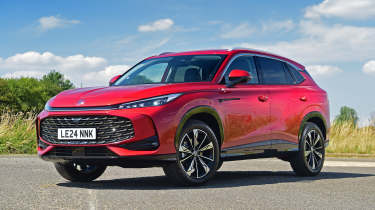
| Pros | Cons |
|
|
The latest MG HS received the maximum five-star crash safety rating from Euro NCAP, scoring higher than the four-star Renault Symbioz and three-star Dacia Duster. The Toyota C-HR also received a five-star rating and scored higher than the HS in the child occupant, vulnerable road user, and safety assistance categories, while the MG did a little better for adult occupant protection.
All versions of HS feature autonomous emergency braking (AEB) with pedestrian and cyclist detection, lane keep assist, blind spot detection and driver attention alert, to name but a few of the systems onboard. As we mentioned, the constant chimes caused by these systems are incredibly annoying and highly distracting when driving.
The MG HS didn’t appear in the 2024 Driver Power customer satisfaction survey’s list of top models as it’s too new. We can see that in the latest survey, MG came in last place overall in the manufacturer poll, so it’s clear the brand has some work to do when it comes to impressing its customers.
| Key standard safety features | Euro NCAP safety ratings |
|
Buying and owning
- Best buy: MG HS Plug-In Hybrid SE engine trim level
We haven’t yet tried the Hybrid+ version, so out of the petrol and plug-in hybrid models we have driven so far, the plug-in hybrid is our preferred choice. It’s more refined overall and doesn’t suffer the same braking issues we encountered with the petrol. It’s usefully faster, and has plenty of electric range.
While the top-of-the-range Trophy comes with lots of equipment, the SE isn’t exactly spartan and saves you £2,500 in the process.
The MG HS comes with a seven-year/80,000-mile warranty as standard, which is among the longest offered by a mainstream manufacturer. It’s very nearly a match for the seven-year/100,000-mile warranty provided by Kia, plus it’s not conditional on yearly services like the 10 years of coverage Toyota promises its customers. There’s only one year of breakdown cover provided with a new MG, whereas rivals such as Renault offer three years of coverage.
Service intervals for the MG HS are every year or 15,000 miles, whichever comes first. You’ll need to have the car serviced on time to maintain the manufacturer's warranty, but the intervals are pretty normal, so even higher-mileage drivers won’t have to worry too much about constant servicing costs.
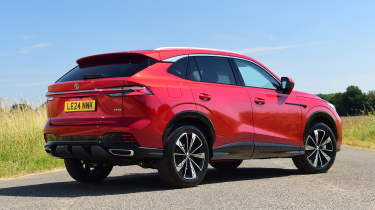
Alternatives
The MG HS is about £5,000 cheaper than the most basic Nissan Qashqai or Kia Sportage, and roughly £7k less than the opening price for a Ford Kuga or Hyundai Tucson. Cars much closer in price to the HS are small SUVs like the Ford Puma. However, the larger, more family-oriented MG even manages to undercut that car’s near £26,000 starting price.
Deals on the MG HS and alternatives


MG HS pictures
Frequently Asked Questions
The plug-in hybrid MG HS is the version we’d recommend because it offers a much more refined and polished driving experience, has a hugely impressive 75-mile EV range, and is no less practical than the pure-petrol models. Prices start from around £31,500.
